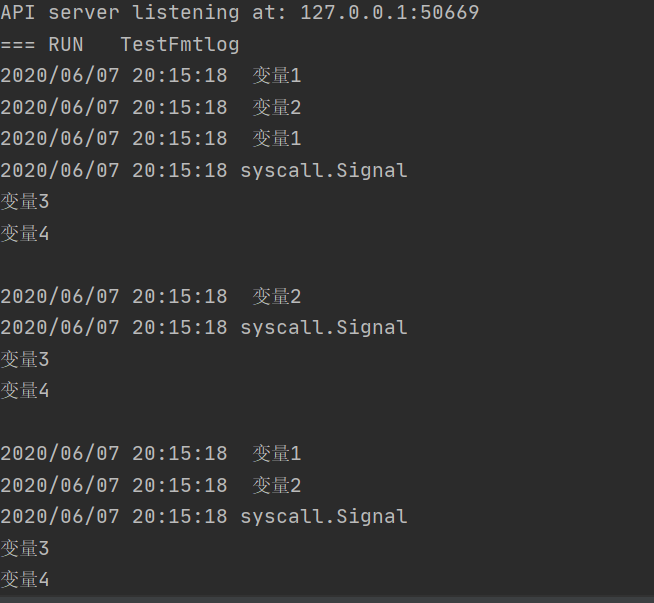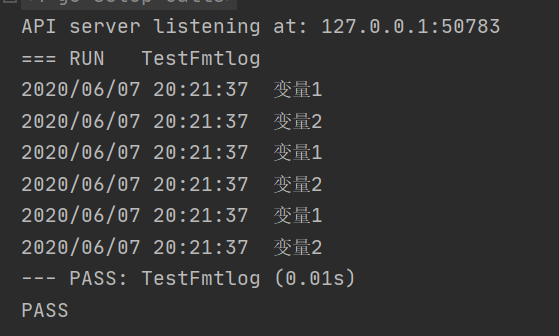

golang日志篇-log与fmt区别
source link: https://xiaomozhang.github.io/2021/10/08/golang-log-with-fmt-different/
Go to the source link to view the article. You can view the picture content, updated content and better typesetting reading experience. If the link is broken, please click the button below to view the snapshot at that time.

最近在排查golang服务上报丢失日志的问题。发现服务中记录日志的操作大部分使用都是golang log包下的工具类进行操作的,那么log与fmt二者有什么区别?通过下面的样例来具体了解下二者的区别。
1:线程安全层面
我们可以运行以下示例
func TestFmtlog(t *testing.T) {
group := sync.WaitGroup{}
group.Add(3)
for i := 0; i < 3; i++ {
go func() {
log.Printf(" %s\n", "变量1")
log.Printf(" %s\n", "变量2")
sigTerm := syscall.Signal(15)
log.Println(reflect.TypeOf(sigTerm))
fmt.Println("变量3")
fmt.Println("变量4")
fmt.Printf("\n")
group.Done()
}()
}
group.Wait()
}输出结果:

从中我们可以看到程序中由于使用fmt输出的顺序并不是一致的,也就是fm并不是线程安全的,那么我们试下去掉fmt的输出效果呢?
代码:
func TestFmtlog(t *testing.T) {
group := sync.WaitGroup{}
group.Add(3)
for i := 0; i < 3; i++ {
go func() {
log.Printf(" %s\n", "变量1")
log.Printf(" %s\n", "变量2")
group.Done()
}()
}
group.Wait()
}输出效果:

从演示样例中我们可以看到,log.Println是线程安全的。到底是不是这样呢?我们先看下
1、1 Logger的定义结构
type Logger struct {
mu sync.Mutex // ensures atomic writes; protects the following fields
prefix string // prefix to write at beginning of each line
flag int // properties
out io.Writer // destination for output
buf []byte // for accumulating text to write
}主要有5个成员,分别的含义:
prefix:表示Log前缀的.
flag:表示Log头标签的
out:Log的输出目的地。
buf是一个字节数组,主要用来存放即将刷入out的内容,相当于一个临时缓存,在对输出内容进行序列化时作为存储目的地。
mu是一个mutex主要用来作线程安全的实习,当有多个goroutine同时往一个目的刷内容的时候,通过mutex保证每次写入是一条完整的信息。
1.2 std及整体结构
log模块提供了一套包级别的简单接口,使用该接口可以直接将日志内容打印到标准错误。那么该过程是怎么实现的呢?其实就是通过一个内置的Logger类型的变量”std” 来实现的。该变量使用:
var std = New(os.Stderr, "", LstdFlags)进行初始化,默认输出到系统的标准输出 “os.Stderr” ,前缀为空,使用日期加时间作为Log抬头。
当我们调用 log.Print的时候是怎么执行的呢?我们看其代码:

这里实际就是调用了Logger对象的 Output方法,将日志内容按照fmt包中约定的格式转义后传给Output。Output定义如下 :
func (l *Logger) Output(calldepth int, s string) error 其中s为日志没有加前缀和Log抬头的具体内容,xxxxx 。该函数执行具体的将日志刷入到对应的位置。
1.3 核心函数的实现
Logger.Output是执行具体的将日志刷入到对应位置的方法。
该方法首先根据需要获得当前时间和调用该方法的文件及行号信息。然后调用formatHeader方法将Log的前缀和Log抬头先格式化好 放入Logger.buf中,然后再将Log的内容存入到Logger.buf中,最后调用Logger.out.Write方法将完整的日志写入到输出目的地中。
由于写入文件以及拼接buf的过程是线程非安全的,因此使用mutex保证每次写入的原子性。
l.mu.Lock()
defer l.mu.Unlock()将buf的拼接和文件的写入放入这个后面,使得在多个goroutine使用同一个Logger对象是,不会弄乱buf,也不会杂糅的写入。
该方法的第一个参数最终会传递给runtime.Caller的skip,指的是跳过的栈的深度。这里我记住给2就可以了。这样就会得到我们调用log 是所处的位置。
在golang的注释中说锁住runtime.Caller的过程比较重,这里的Logger里带有一个Mutex锁,方便在高并发或者多协程的时候保护上下文数据一致,只是从代码中看到其在这里把锁打开了。
defer l.mu.Unlock()
if l.flag&(Lshortfile|Llongfile) != 0 {
// Release lock while getting caller info - it's expensive.
l.mu.Unlock()
var ok bool
_, file, line, ok = runtime.Caller(calldepth)
if !ok {
file = "???"
line = 0
}
l.mu.Lock()
}在formatHeader里面首先将前缀直接复制到Logger.buf中,然后根据flag选择Log抬头的内容,这里用到了一个log模块实现的itoa的方法,作用类似c的itoa,将一个整数转换成一个字符串。只是其转换后将结果直接追加到了buf的尾部。
纵观整个实现,最值得学习的就是线程安全的部分。在什么位置合适做怎样的同步操作。
1.4 对外接口的实现
在了解了核心格式化和输出结构后,在看其封装就非常简单了,几乎都是首先用Output进行日志的记录,然后在必要的时候 做os.exit或者panic的操作,这里看下Fatal的实现。
func (l *Logger) Fatal(v ...interface{}) {
l.Output(2, fmt.Sprint(v...))
os.Exit(1)
}
// Fatalf is equivalent to l.Printf() followed by a call to os.Exit(1).
func (l *Logger) Fatalf(format string, v ...interface{}) {
l.Output(2, fmt.Sprintf(format, v...))
os.Exit(1)
}
// Fatalln is equivalent to l.Println() followed by a call to os.Exit(1).
func (l *Logger) Fatalln(v ...interface{}) {
l.Output(2, fmt.Sprintln(v...))
os.Exit(1)
}这里也验证了我们之前做的Panic的结果,先做输出日志操作。再进行panic。
2:制定指定的日志内容输出格式
我们可以通过以下代码进行对log输出的日志进行输出详细的日志信息
#指定输出date与time输出以及执行代码日志的行号
log.SetFlags(log.LstdFlags | log.Llongfile)
具体更多选项设置可以参见log中源码
const (
Ldate = 1 << iota // the date in the local time zone: 2009/01/23
Ltime // the time in the local time zone: 01:23:23
Lmicroseconds // microsecond resolution: 01:23:23.123123. assumes Ltime.
Llongfile // full file name and line number: /a/b/c/d.go:23
Lshortfile // final file name element and line number: d.go:23. overrides Llongfile
LUTC // if Ldate or Ltime is set, use UTC rather than the local time zone
LstdFlags = Ldate | Ltime // initial values for the standard logger
)输出格式样例:

3:将日志信息进行转存,形成日志文件
具体我们可以查看log的new方法
func New(out io.Writer, prefix string, flag int) *Logger {
return &Logger{out: out, prefix: prefix, flag: flag}
}
然后直接调用log中的Println的方法输出日志即可,就会将日志内容追加到日志文件中。
最后,打印信息的话 一般也不用fmt,fmt一般用来格式化. 所以特殊需求也就不要用fmt了.希望大家有其它方面的个人见解随时私聊我,我们公共成长,一起进步。
Recommend
-
 31
31
golang fmt格式“占位符” qing123 · 2015-03-21 03:00:01 · 43307 次点击 · 预计阅读时间 2 分钟 · 大约1分钟之前 开始浏览 这是一个创建于 2015-03-21 03:00:01 的文章,其中的信息可能已经有所发展或是发生改变...
-
 41
41
golang 的fmt 包实现了格式化I/O函数,类似于C的 printf 和 scanf。 // 定义示例类型和变量 type Human struct { Name string } var people = Human{Name:"zhangsan"} 1、普通占位符: 占位符...
-
 36
36
fmt包实现了类似C语言printf和scanf的格式化I/O。格式化动作('verb')源自C语言但更简单。 Printing verb: 通用: %v 值的默认格式表示 %+v 类似%v,但输出结构体时会添加字...
-
 8
8
golang fmt格式“占位符” qing123 · 2015-03-21 03:00:01 · 106671 次点击 · 预计阅读时间 2 分钟 · 不到1分钟之前 开始浏览 ...
-
 7
7
[Golang] Create Template Using fmt.Sprintf November 27, 2018 In
-
 6
6
[Golang] Caveat of fmt.Fprintf Use March 01, 2017 Do not use
-
 5
5
In Go, we have two easy methods to create new or custom error - either errors.New or fmt.Errorf in Go standard...
-
 11
11
[Golang] Convert Integer to String via fmt.Sprintf May 28, 2018
-
 0
0
fmt 是 Go 用于日志打印的库: 模板模式: [name]f 根据模板格式化 例如: Printf 换行模式: [name]ln 输出后带换行 例如: Println Print 打印数...
-
 3
3
Golang 记一次log日志不能输出的问题 由于线上运行程序过程中出现了log日志打印不出来的情况,分析代码模拟测试复现问题。由于没有锁住log变量的问题 目录结构如下 . ├── ccc │ └── ccc.g...
About Joyk
Aggregate valuable and interesting links.
Joyk means Joy of geeK